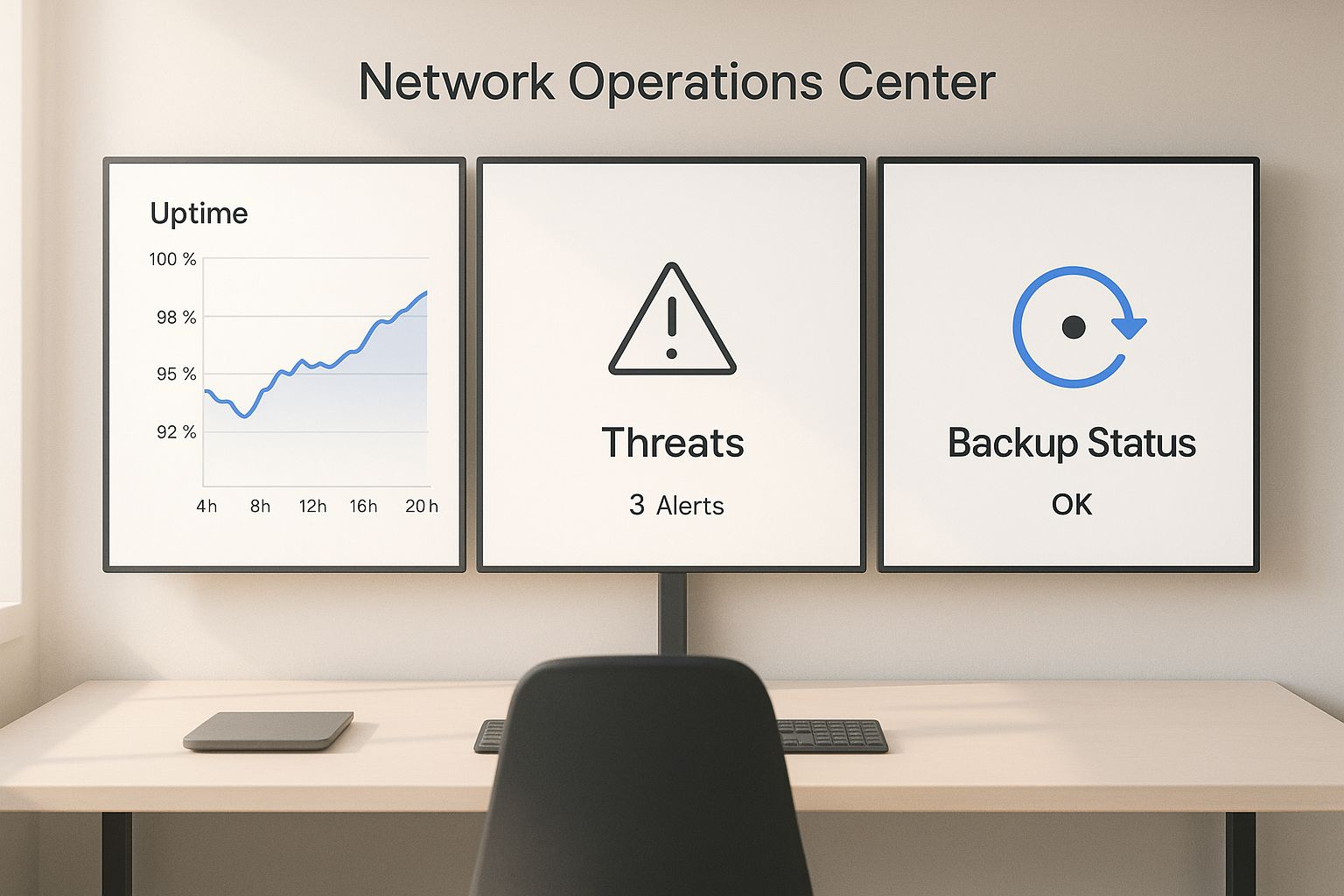Picture your business's IT running like a utility-always on, always reliable, and managed by experts for a simple, flat monthly fee. That’s the core idea behind information technology managed services. Instead of waiting for a critical system to fail, this approach is all about preventing problems before they even start.
Understanding the Shift to Proactive IT Management

Many businesses still get by on the old 'break-fix' model. When a laptop crashes or a server goes down, they scramble to call an IT technician for an emergency repair. The trouble is, this reactive method leads to unpredictable costs and frustrating downtime, often grinding crucial business operations to a halt.
Information technology managed services flips this model completely on its head. A dedicated partner, known as a Managed Service Provider (MSP), takes full responsibility for your entire technology infrastructure. Their goal is to keep everything running so smoothly that those emergency calls never happen in the first place.
Think of an MSP less like a firefighter and more like a fire marshal-they focus on prevention and safety, not just putting out fires.
From Reactive Repairs to Strategic Partnership
An MSP's role goes far beyond simple troubleshooting. They become a strategic partner, working to align your technology directly with your business goals. This relationship is built on a proactive foundation, which almost always includes:
- Continuous Monitoring: Your systems, networks, and devices are watched 24/7 to spot and resolve potential issues long before they can cause disruption.
- Proactive Maintenance: Regular updates, security patching, and system optimisations are handled quietly in the background to guarantee performance and security.
- Comprehensive Security: An MSP provides layers of protection, from managing firewalls and antivirus software to defending against phishing and other cyber threats.
- Predictable Costs: Instead of dealing with fluctuating repair bills, you pay a fixed monthly fee. This turns your IT expenses into a predictable, manageable operational cost.
An MSP’s success is tied directly to your stability. When your systems are up and running without issue, they are doing their job correctly. This shared goal creates a true partnership focused on your business's continuity and growth.
This proactive approach is quickly becoming the new standard. In fact, the UK managed IT services market, valued at £15.35 billion in 2023, is projected to surge to £28.29 billion by 2032. This shows a massive shift in how businesses view and manage their technology.
Identifying the Need for a Change
So, how do you know if your business could benefit from this model? Often, the signs are subtle-slow computers, recurring email problems, or a nagging feeling about your data security. Recognising these issues early is key.
To figure out if your current setup is holding you back, you might be interested in these 10 warning signs your business needs managed IT services. And to get a clearer picture of what's involved, it's worth understanding the fundamentals of IT managed support.
Exploring the Core Managed IT Services
A good partnership with a Managed Service Provider (MSP) is built on a handful of specific, proactive services designed to keep your creative business stable and secure. These aren't just one-off fixes; they work together to create a protective, always-on layer over your entire tech setup.
Think of it like the expert crew running a busy film set. One person is constantly checking the lighting, another manages the sound equipment, and a third ensures the cameras are always ready to roll. They all work in sync to prevent technical glitches from derailing the creative process. A great MSP does the same for your technology, managing each part so the whole system just works.
The infographic below gives you a glimpse into an MSP's operations centre, where they keep a constant eye on your business's vital signs-from network uptime to security alerts.

This centralised view is the key. It lets an MSP spot and fix potential problems long before they ever get a chance to slow your team down.
Proactive Network Monitoring and Management
The most fundamental service is 24/7 network monitoring. Instead of waiting for the internet to drop or a server to crash-grinding all work to a halt-an MSP continuously watches over your network's health. They use specialised software that alerts technicians to early warning signs, like unusual traffic patterns or a piece of hardware that's starting to fail.
This constant vigilance means they can step in and resolve issues, often before you or your team even notice anything is wrong. The result is a dramatic drop in unexpected, costly downtime, which is vital for keeping your projects on track and clients happy.
Comprehensive Cybersecurity Solutions
In today's world, protecting your data is non-negotiable. MSPs deliver multi-layered security that goes far beyond just installing some basic antivirus software. This is a critical part of what information technology managed services are all about.
These security measures typically include:
- Managed Firewalls: Think of this as an expert gatekeeper for your network. It's configured and constantly updated by specialists to block malicious traffic from ever getting in.
- Threat Detection and Response: Advanced systems are always on the hunt for suspicious activity. If they find something, they can automatically isolate the threat to stop it from spreading.
- Security Awareness Training: Many MSPs also help train your team to spot phishing emails and avoid common scams. This turns your staff into a surprisingly effective first line of defence.
A strong cybersecurity strategy isn't just about software-it's about building a resilient defence. An MSP brings together powerful tools with expert human oversight to protect your creative assets and client data from harm.
Data Backup and Disaster Recovery
Stop and think: what would happen if your most important project files vanished tomorrow? A hardware failure, a ransomware attack, or even a simple accident could wipe them out. A solid backup and disaster recovery plan ensures your business can bounce back quickly from any data loss.
An MSP automates regular backups of your critical data, storing copies securely both on-site and in the cloud. More importantly, they create and test a recovery plan, so if the worst does happen, they can restore your systems with minimal disruption. It’s the kind of service that gives you true peace of mind.
Cloud Services and Helpdesk Support
As more creative work moves into the cloud, managing platforms like Microsoft 365 or Google Workspace gets more complicated. MSPs offer expert support here, helping you get the most out of these powerful tools. If you want to go deeper, you can learn more about how an MSP handles managed IT and cloud services to support business goals.
Finally, a responsive helpdesk is the human face of managed services. When someone on your team has a question or hits a technical snag, they have a direct line to friendly, expert support. This frees your people up to solve problems fast and stay focused on their creative work, rather than getting stuck on frustrating IT issues.
Comparing IT Support Models
Picking the right way to manage your technology is a huge decision for any modern business. The choice you make ripples through everything, from day-to-day productivity and data security to your long-term budget and ability to grow.
To get it right, it helps to see the three main approaches side-by-side: the traditional in-house IT team, the chaotic break-fix model, and proactive information technology managed services. Each runs on a completely different philosophy, and knowing the difference is key to finding the right fit for your organisation.
The In-House IT Department
Lots of larger businesses choose to build their own internal IT team. This gives you a dedicated group of employees who know your company’s specific quirks and culture inside out. They’re right there, on-site, ready to jump on issues as they pop up, which gives you a real sense of control.
But this control comes at a steep price. You're on the hook for salaries, benefits, constant training, and the eye-wateringly expensive tools they need. Even then, a small team can easily get overwhelmed. Covering the vast range of specialisms needed today-from cloud architecture to advanced cybersecurity-is a massive ask, and providing genuine 24/7 support is a surefire recipe for burnout.
The Reactive Break-Fix Model
The break-fix model is the simplest approach, and honestly, often the most stressful. It works exactly like it sounds: when something breaks, you call a technician to fix it. You pay them by the hour or per job, which can feel cheap at first.
The problem is, this model is built on a fundamental conflict of interest. The technician only makes money when your systems are down, so there's zero incentive for them to stop problems from happening in the first place. This locks you into a painful cycle of unexpected downtime, unpredictable costs, and recurring frustrations that can grind your entire operation to a halt.
The core flaw of the break-fix model is its reactive nature. It forces your business to absorb the full impact of a problem before any action is taken, making it an expensive and inefficient way to manage critical systems.
Proactive Information Technology Managed Services
Managed services flip the script entirely. Instead of waiting for things to go wrong, you pay a Managed Service Provider (MSP) a flat monthly fee to keep your IT environment running smoothly and securely. Their entire goal is to prevent issues before they happen, which means their success is directly tied to your stability and uptime.
This proactive approach turns IT from a source of unpredictable capital expenditure into a steady, predictable operational cost. An MSP gives you access to a deep bench of specialists and enterprise-grade tools that would be far too costly for most small or medium-sized businesses to buy themselves. It's a model built for scalability and security, turning technology into a reliable asset instead of a constant headache.
Comparison of IT Support Models
To really see how these models stack up, the table below breaks down each one across the things that matter most to a business. It highlights how each approach handles costs, service, and strategic value, making it easier to see which one aligns with your goals.
| Feature | In-House IT Team | Break-Fix Model | Managed Services (MSP) |
|---|---|---|---|
| Cost Structure | High fixed costs (salaries, benefits, training) | Unpredictable, hourly-based costs | Predictable, fixed monthly fee |
| Service Philosophy | Dedicated but limited by team size and skills | Reactive (waits for problems to occur) | Proactive (focuses on prevention) |
| Access to Expertise | Limited to the skills of your hired staff | Varies by technician; no long-term relationship | Access to a broad team of specialists |
| Scalability | Difficult and expensive to scale up or down | Does not scale; service is incident-based | Highly scalable to match business growth |
| Strategic Value | Can be strategic but often tied up in daily tasks | Little to no strategic input or planning | Acts as a strategic partner to align IT with goals |
Ultimately, the right choice depends on your company’s size, goals, and tolerance for risk. But for businesses that want predictable costs, deep expertise, and a partner invested in their success, the proactive model offered by an MSP is hard to beat.
The Strategic Benefits for Modern Businesses

Bringing a Managed Service Provider (MSP) on board is far more than just outsourcing your tech support. It’s a strategic decision, and it delivers some seriously powerful advantages. For businesses across the UK, switching to information technology managed services marks a fundamental shift from reacting to problems to proactively building strength and stability.
It’s about creating a solid foundation that lets your business grow without being tripped up by technology.
One of the first things you’ll notice is the financial predictability. The old break-fix model is inherently chaotic; an unexpected server failure or an emergency call-out can generate an invoice that completely derails your quarterly budget. An MSP, on the other hand, works on a simple, fixed monthly fee. Your IT spend transforms from a volatile capital expense into a steady, predictable operational cost.
This simple change makes financial planning so much easier and more accurate. When you know exactly what your core IT support will cost each month, you can allocate your resources with confidence, pushing investment towards growth instead of holding cash back for the next tech disaster.
Predictable Costs and Increased Efficiency
The steady, predictable nature of managed services is just the beginning. While it provides budget stability, it often leads to significant long-term savings, too. Think about it: an MSP's entire business model is built on keeping your systems running smoothly to minimise support tickets. Their success is tied to your stability.
This proactive maintenance-regular updates, security patching, performance monitoring-catches the small issues before they can snowball into major, expensive failures. By preventing downtime, an MSP directly protects your revenue and productivity. You can explore more of these financial and operational advantages of managed IT services in our detailed guide.
Access to Enterprise-Grade Expertise
For most small and medium-sized businesses, hiring, training, and retaining an in-house IT team with deep expertise in cybersecurity, cloud infrastructure, and network engineering is just too expensive. A partnership with an MSP gives you instant access to a whole team of specialists for a fraction of that cost.
This team brings a wealth of experience gained from working across hundreds of different business environments. They provide a level of knowledge and skill that a small internal team would struggle to match, ensuring your tech isn't just stable but also aligned with current best practices.
By entrusting your technology to a managed services partner, you are not just buying support-you are investing in a strategic asset. The focus shifts from merely fixing what is broken to building a secure, resilient, and efficient technology foundation that actively supports your business objectives.
Enhanced Security and Compliance
Trying to navigate today’s complex web of security and compliance requirements is a major challenge for any business. Threats are constantly evolving, and regulations like GDPR demand strict data protection measures. The stakes have never been higher.
An MSP provides the specialised security knowledge needed to properly protect your business. They implement and manage multiple layers of security, from advanced firewalls to sophisticated threat detection systems, all designed to safeguard your sensitive data.
What’s more, they offer expert guidance on meeting compliance standards, helping you avoid the severe penalties that come with data breaches. This robust security posture not only protects your business but also builds trust with your clients. The market reflects this growing reliance on expert management; globally, managed services are projected to grow from an estimated USD 441.1 billion in 2025 to USD 1,314.9 billion by 2035.
How to Choose the Right MSP Partner
Moving to a managed services model is a huge step, and frankly, finding the right partner is the single most important thing you'll do. Get it right, and your business gains a massive advantage. Get it wrong, and you're in for a world of frustration.
Making a good choice isn’t about a quick Google search. It requires a clear, structured approach to find a partner who genuinely gets what you do and can deliver real, measurable results.
The process doesn't start with looking at providers. It starts with looking in the mirror. Before you can find the right fit, you need a crystal-clear understanding of your own business. What are your biggest IT headaches right now? Which systems are absolutely critical to delivering client work? Where do you see the business in three to five years?
Answering these questions gives you a benchmark. It turns a vague desire for "better IT" into a concrete list of needs and goals you can measure a potential partner against.
Assess Your Own Needs and Goals
First up, document your current IT setup. You don’t need to be a tech wizard-just make a list. Run through these points to build a clear picture of what you actually need:
- Business Objectives: Are you planning to grow the team, launch a new service, or move more of your workflow into the cloud? The right MSP should be enabling these goals, not just fixing broken laptops.
- Pain Points: What’s holding you back? Be specific. Is it slow system performance killing your designers' flow? Recurring software glitches? That nagging worry about data security? Or just painfully slow responses from your current support?
- Compliance Needs: Do you handle sensitive client data that falls under regulations like GDPR? If so, you need an MSP with proven, real-world experience in keeping businesses like yours compliant. It’s not an optional extra.
- Budgeting: Get a handle on what you're currently spending on IT. Add up everything-hardware, software subscriptions, and those surprise ad-hoc repair bills. Knowing your numbers is vital. When you start talking to MSPs, understanding different Managed Service Provider pricing models is crucial for matching services to what you can realistically afford.
Vet Potential MSPs Thoroughly
Once you know exactly what you need, it's time to start sizing up potential partners. Look past the slick marketing brochures and dig into the specifics of what they actually deliver. A reputable provider of information technology managed services will be totally transparent and ready to prove their capabilities.
Key areas to investigate are their technical certifications, their experience in your industry, and what their clients have to say. Don't be shy about asking for case studies or references from businesses similar to yours. An MSP with a strong track record in the creative sector, for example, will already understand the unique software and workflow demands of an agency or studio. To help you cover all your bases, there are plenty of helpful guides that list the essential things to consider when hiring an MSP-they make for a great checklist.
Scrutinise the Service Level Agreement
The Service Level Agreement (SLA) is the most important document in your relationship with an MSP. This is the contract that defines every single part of the service you'll receive, and you need to understand it completely before signing anything. A vague or poorly defined SLA is a massive red flag.
A solid SLA will have specific, measurable metrics for all the key services.
The SLA isn't just a formality-it's the foundation of your entire relationship with an MSP. It sets clear expectations, provides a mechanism for accountability, and ensures that the services delivered are aligned directly with your business requirements.
Look for crystal-clear definitions of the following:
- Response and Resolution Times: The SLA must state exactly how quickly the MSP will acknowledge a support request and how long they have to fix it, usually based on how severe the issue is.
- Uptime Guarantees: For critical systems like your servers and network, the SLA should guarantee a specific percentage of uptime, like 99.9%.
- Support Availability: Does their support cover your actual business hours? If you have team members burning the midnight oil or working on weekends, you need to know the helpdesk will be there when they need it.
- Reporting and Reviews: The agreement must outline how and when the MSP will report on their performance. This should include regular strategic review meetings to discuss progress and plan for the future.
The Future of Managed IT Services in the UK
The world of IT management is constantly shifting, and managed services are right at the forefront of that change. For businesses across the UK, this isn't just about handing over your IT problems to someone else; it's a strategic move towards a smarter, forward-thinking approach that turns technology into a genuine asset. The future of these partnerships is being shaped by some powerful new trends.
This shift is happening within a booming sector. The UK's IT services market is a huge part of the nation's economy, hitting USD 40.2 billion in 2024. And it's not slowing down, with forecasts predicting it will rocket past USD 100.7 billion by 2033. This isn't just numbers on a page; it shows a deep, widespread move towards embracing advanced tech. You can dig into the data on the UK IT services market's growth trajectory.
This growth is powered by technology that's making information technology managed services more intelligent and proactive than ever before.
The Rise of Predictive and Automated IT
One of the biggest game-changers is the fusion of artificial intelligence (AI) and machine learning. Tomorrow's Managed Service Providers (MSPs) are leaving the old break-fix model behind. They’re no longer just reacting to alerts.
Instead, they're using AI to predict problems before they happen. Think of it as preventative maintenance for your tech-identifying hardware that's about to fail and swapping it out before it can cause a second of downtime. This also applies to security, where AI-driven systems can spot and neutralise sophisticated threats in real-time, often without a human needing to lift a finger. Problems aren't just fixed quickly; they're stopped before they can even start.
The next generation of managed IT isn't about response times-it's about making the response unnecessary. By using predictive analytics and automation, MSPs can create an IT environment that is self-healing, self-securing, and incredibly resilient.
Co-Managed IT: A Flexible Hybrid Model
But the future isn't a one-size-fits-all, fully outsourced model. A more flexible approach, known as co-managed IT, is gaining serious traction. This hybrid setup creates a powerful partnership between your in-house IT people and an external MSP.
Instead of replacing your team, the MSP complements it. They fill critical knowledge gaps and bring specialist skills to the table, turbocharging what your team can already do. It’s the best of both worlds:
- Your internal team keeps its deep, invaluable knowledge of your business culture and day-to-day quirks.
- The MSP brings specialised expertise in areas like advanced cybersecurity or cloud architecture, along with enterprise-grade tools you couldn't justify buying yourself.
- Together, they build an IT function that's more robust, capable, and effective than either could be alone.
This collaborative approach is perfect for businesses with some internal IT resources but needing to scale up or tackle complex projects. It ensures you have the exact expertise you need, right when you need it. As technology and cyber threats grow ever more complex, this adaptable partnership model is a smart, secure, and empowering strategy for the years ahead.
Frequently Asked Questions
Even with a better grasp of managed IT, you probably still have a few questions about how it all works in the real world. Let's tackle some of the most common ones that come up when business leaders are thinking about partnering with a Managed Service Provider (MSP).
Our aim here is to clear up any lingering doubts, helping you make a solid, well-informed decision for your company.
How Quickly Can I Expect Support?
This is a big one, and rightly so. The answer should be spelled out clearly in your Service Level Agreement (SLA). Any decent MSP will offer different response times based on how serious the problem is. A server outage? That needs an immediate, all-hands-on-deck response. A forgotten password? That’ll have a slightly longer, but still guaranteed, window.
For example, a typical SLA might promise a 15-minute response for critical issues and a one-hour response for standard support tickets. Always, always confirm these numbers before you sign anything to make sure they fit with how your business operates.
What Happens if We Already Have an IT Person?
This is a really common setup, and it’s where a co-managed IT model shines. An MSP doesn’t have to replace your internal team; they can work right alongside them, creating a much stronger, more capable IT function for your business.
A co-managed partnership lets your internal expert focus on the big-picture, business-specific projects, while the MSP handles the relentless day-to-day grind of monitoring, maintenance, and security. It’s a team approach that boosts your existing capabilities without you having to hire more people.
This hybrid model gives you the best of both worlds: the deep institutional knowledge of your own staff, plus the specialised expertise and powerful tools of an MSP.
Are Managed Services Only for Large Companies?
Not at all. While the big players certainly get a lot out of them, information technology managed services are a game-changer for small and medium-sized businesses (SMBs). Most SMBs simply don’t have the budget to build a full-blown, in-house IT department with specialists in things like cybersecurity and cloud tech.
Working with an MSP gives smaller companies access to enterprise-grade tools and a deep bench of experts for a predictable monthly fee. It completely levels the playing field, allowing them to compete more effectively and securely without the massive upfront investment needed to build a comparable internal team.
Trying to manage your own IT can feel like a constant distraction from what you do best. At InfraZen Ltd, we provide calm, reliable, and future-proof technology so you can focus on your best creative work. Discover how our proactive support can protect your business and drive your goals forward. Learn more about our tailored IT services at InfraZen Ltd.

